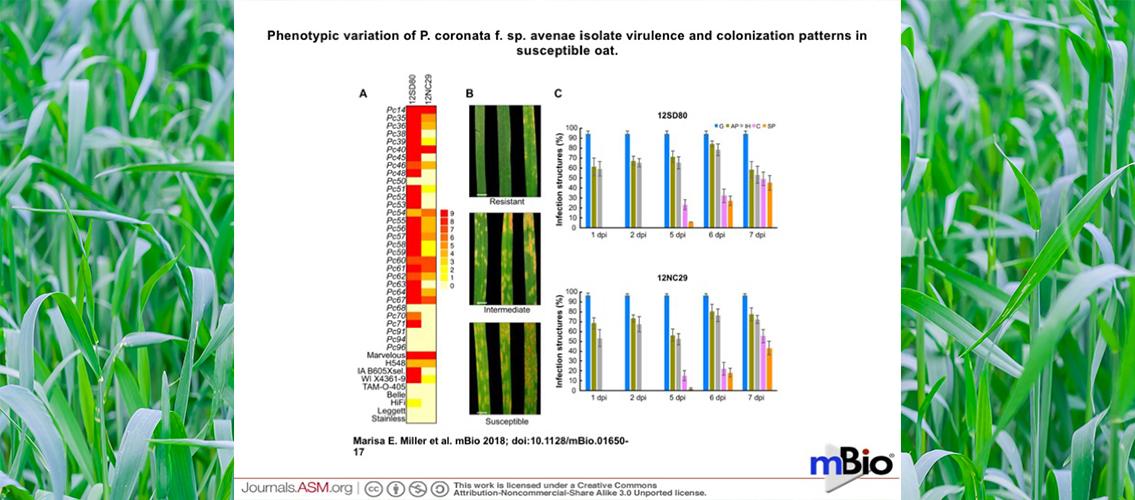
Oat crown rust is a serious disease that affects oat crops worldwide. Because of the problems inherent in using fungicides, researchers are working to develop oat varieties and other crops that carry genetic resistance to pathogens. The pathogen that causes oat crown rust, the fungus Puccinia coronata f. sp. avenae, however, can evolve particularly quickly. This means that an oat crop variety that was previously resistant to the fungus would be susceptible to the newly evolved variant.
P. coronata f. sp. avenae is a dikaryotic organism; that is, it contains two copies of each chromosome. These may carry different versions of virulence genes. In a recent paper, MSI PIs Melania Figueroa (assistant professor, Plant Pathology), Shahryar Kianian (adjunct professor, Plant Pathology; USDA-ARS Cereal Disease Laboratory), and Cory Hirsch (assistant professor, Plant Pathology) and their group members and colleagues revealed that the two nuclei in P. coronata f. sp. avenae have a high degree of diversity, which may contribute to the fungus’s capability for fast evolution. According to this study the genome size of each nucleus is ~100 Mbp. This study is the first time a haplotype-based genome assembly has been completed for a dikaryotic species. Because other rust fungi are also dikaryotic, this method can be extended to study other devastating pathogens that affect cereal crops such as wheat, barley and coffee.
The paper was published in the journal mBio in February 2018 and can be found on the journal’s website: ME Miller, Y Zhang, V Omidvar, J Sperschneider, B Schwessinger, C Raley, JM Palmer, D Garnica, N Upadhyaya, J Rathjen, JM Taylor, RF Park, PN Dodds, CD Hirsch, SF Kianian, M Figueroa. 2018. De Novo Assembly and Phasing of Dikaryotic Genomes From Two Isolates of Puccinia coronata f. sp. avenae, the Causal Agent of Oat Crown Rust. mBio 9(1):e01650-17. doi: 10.1128/mBio.01650-17.
Co-author Dr. Ying Zhang is in the Research Informatics Solutions group at the Minnesota Supercomputing Institute. Dr. Marisa E. Miller and Vahid Omidvar are members of Professor Figueroa’s MSI research group. Dr. Kevin Silverstein, of MSI’s Research Informatics Solutions group, consulted with the authors during the genome assembly and analysis. Dr. Nick Dunn, in MSI’s User Gateway Group, assisted them with software use and installation.
An article about this research appeared on the University of Minnesota website: Scientists Poised to Win the Race Against Rust Disease and Beyond. The other paper discussed in the article was co-authored by Professor Figueroa, and Dr. Zhang provided technical advice.
Image description: Phenotypic variation of P. coronata f. sp. avenae isolate virulence and colonization patterns in susceptible oat. (A) Heatmap showing virulence profiles of 12SD80 and 12NC29 on a set of 40 oat differential lines. Infection type scores were converted to a 0-to-9 numeric scale for heatmap generation. (B) Photographs represent examples of infection types corresponding to full resistance (with a score of 0 to 4) or intermediate resistance (5 or 6), as well as susceptibility (7 to 9). Example photographs show infection of 12SD80 on representative lines of the standard U.S. oat differential set. Scale bar = 0.5 cm. (C) Quantification of infection structures of P. coronata f. sp. avenae isolates in the susceptible oat line Marvelous at 1, 2, 5, 6, and 7 dpi. Graphs show the percentages of urediniospores that have germinated (G) and the percentages of germinated spores that formed appressoria (AP), substomatal vesicles or primary infection hyphae (IH), established colonies (C), and sporulating colonies (SP). Error bars represent standard errors of results from three independent replicates. Image and description from ME Miller et al. mBio 2018; doi: 10.1128/mBio.01650-17.
posted on September 26, 2018